Seat Ateca 2017 Owner's Guide
Manufacturer: SEAT, Model Year: 2017, Model line: Ateca, Model: Seat Ateca 2017Pages: 328, PDF Size: 6.36 MB
Page 21 of 328
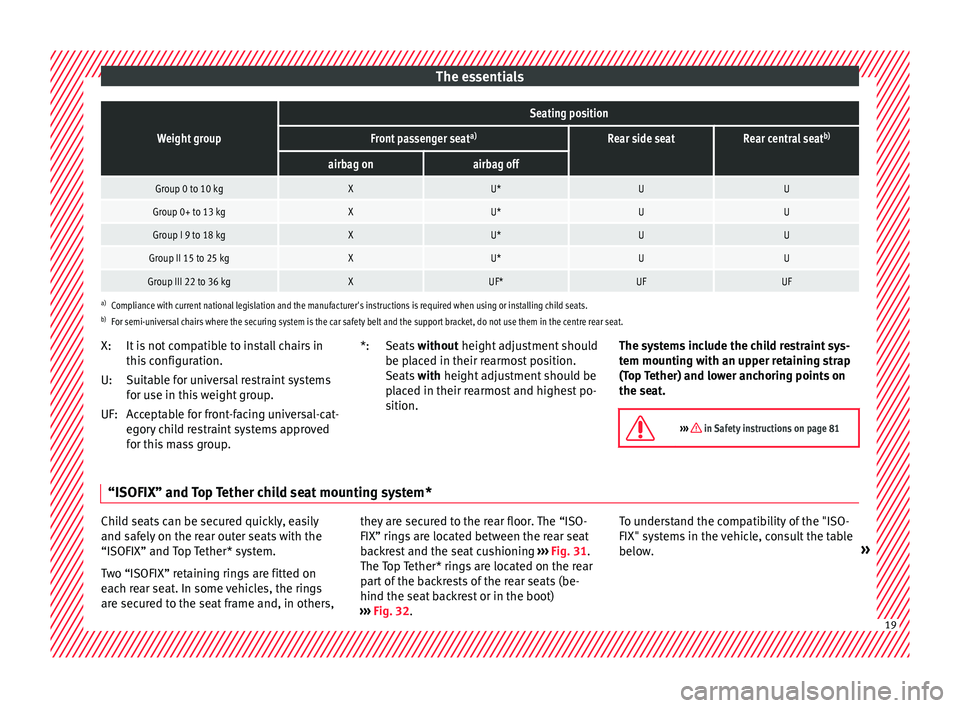
The essentialsWeight group
Seating position
Front passenger seat
a)Rear side seatRear central seatb)
airbag onairbag off
Group 0 to 10 kgXU*UU
Group 0+ to 13 kgXU*UU
Group I 9 to 18 kgXU*UU
Group II 15 to 25 kgXU*UU
Group III 22 to 36 kgXUF*UFUF
a)
Compliance with current national legislation and the manufacturer's instructions is required when using or installing child seats.
b) For semi-universal chairs where the securing system is the car safety belt and the support bracket, do not use them in the centre rear seat.
It is not compatible to install chairs in
this configuration.
Suitable for universal restraint systems
for use in this weight group.
Acceptable for front-facing universal-cat-
egory child restraint systems approved
for this mass group.
X:
U:
UF:
Seats
without height adjustment should
be p laced in their rearmost position.
Seats with height adjustment should be
placed in their rearmost and highest po-
sition.
*:
The systems include the child restraint sys-
tem mou
nting with an upper retaining strap
(Top Tether) and lower anchoring points on
the seat.
››› in Safety instructions on page 81 “ISOFIX” and Top Tether child seat mounting system*
Child seats can be secured quickly, easily
and s
af
ely on the rear outer seats with the
“ISOFIX” and Top Tether* system.
Two “ISOFIX” retaining rings are fitted on
each rear seat. In some vehicles, the rings
are secured to the seat frame and, in others, they are secured to the rear floor. The “ISO-
FIX” ring
s are located between the rear seat
backrest and the seat cushioning ››› Fig. 31.
The Top Tether* rings are located on the rear
part of the backrests of the rear seats (be-
hind the seat backrest or in the boot)
››› Fig. 32. To understand the compatibility of the "ISO-
FIX" sys
tems in the vehicle, consult the table
below. » 19
Page 22 of 328
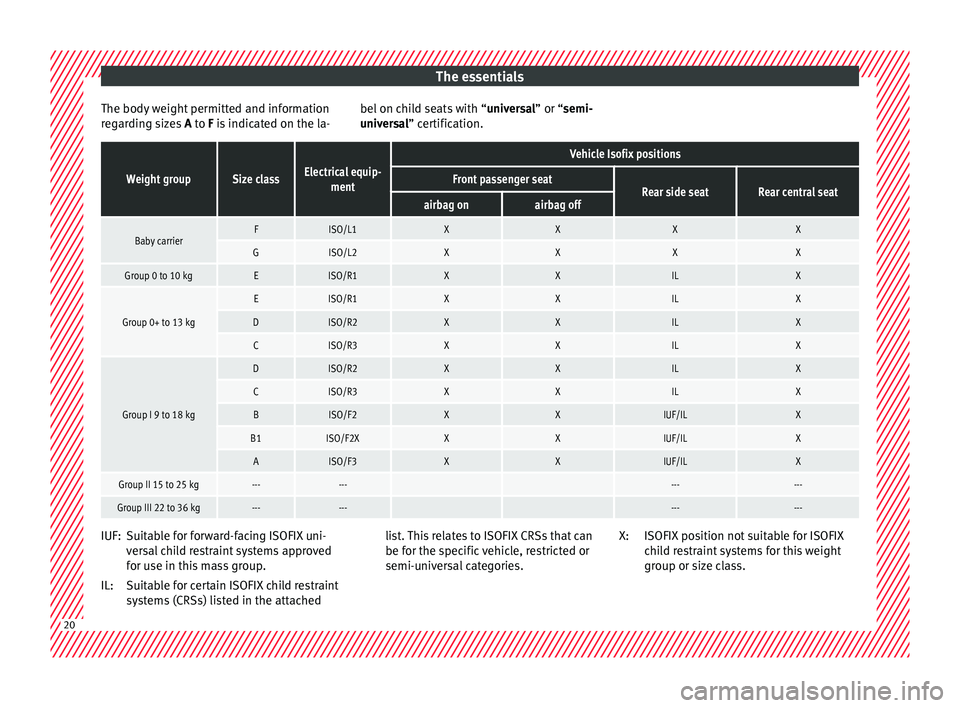
The essentials
The body weight permitted and information
r e
garding sizes A to F is indicated on the la- bel on child seats with “
univ ersal” or “semi-
universal” certification.
Weight groupSize classElectrical equip- ment
Vehicle Isofix positions
Front passenger seatRear side seatRear central seatairbag onairbag off
Baby carrierFISO/L1XXXX
GISO/L2XXXX
Group 0 to 10 kgEISO/R1XXILX
Group 0+ to 13 kg
EISO/R1XXILX
DISO/R2XXILX
CISO/R3XXILX
Group I 9 to 18 kg
DISO/R2XXILX
CISO/R3XXILX
BISO/F2XXIUF/ILX
B1ISO/F2XXXIUF/ILX
AISO/F3XXIUF/ILX
Group II 15 to 25 kg------ ------
Group III 22 to 36 kg------ ------ Suitable for forward-facing ISOFIX uni-
v
er
sal child restraint systems approved
for use in this mass group.
Suitable for certain ISOFIX child restraint
systems (CRSs) listed in the attached
IUF:
IL:
list. This relates to ISOFIX CRSs that can
be for the s
pecific vehicle, restricted or
semi-universal categories. ISOFIX position not suitable for ISOFIX
chi
ld restraint systems for this weight
group or size class.
X:
20
Page 23 of 328
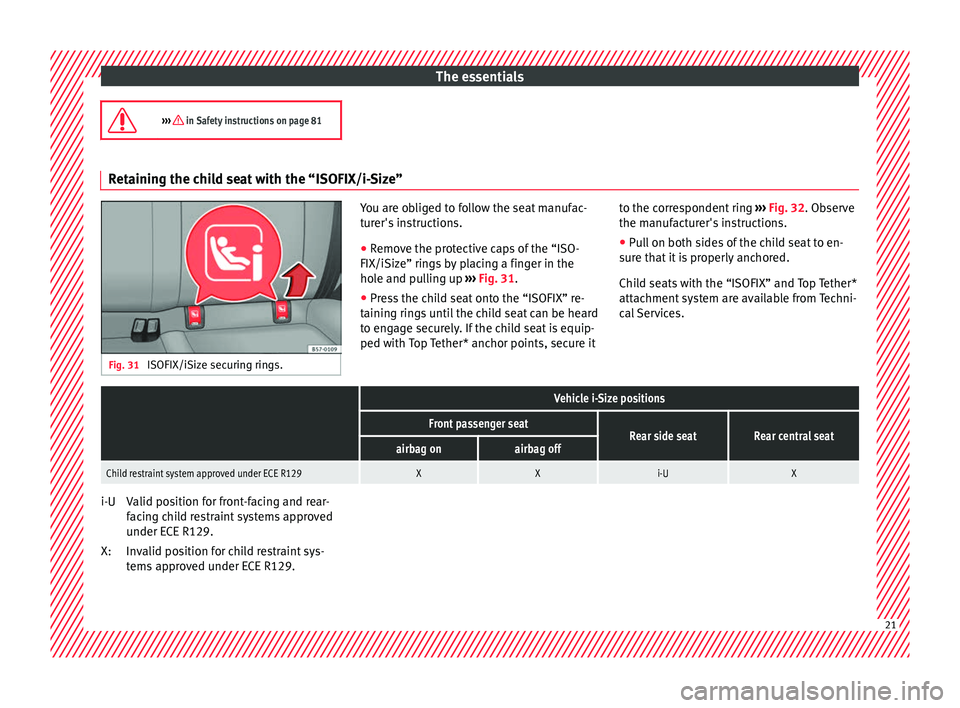
The essentials
››› in Safety instructions on page 81 Retaining the child seat with the “ISOFIX/i-Size”
Fig. 31
ISOFIX/iSize securing rings. You are obliged to follow the seat manufac-
t
ur
er's instructions.
● Remove the protective caps of the “ISO-
FIX/iSize” rin
gs by placing a finger in the
hole and pulling up ››› Fig. 31.
● Press the child seat onto the “ISOFIX” re-
tainin
g rings until the child seat can be heard
to engage securely. If the child seat is equip-
ped with Top Tether* anchor points, secure it to the correspondent ring
››
› Fig. 32. Observe
the manufacturer's instructions.
● Pull on both sides of the child seat to en-
sur
e that it is properly anchored.
Child seats with the “ISOFIX” and Top Tether*
attachment system are available from Techni-
cal Services.
Vehicle i-Size positions
Front passenger seatRear side seatRear central seatairbag onairbag off
Child restraint system approved under ECE R129XXi-UX Valid position for front-facing and rear-
f
ac
ing child restraint systems approved
under ECE R129.
Invalid position for child restraint sys-
tems approved under ECE R129.
i-U
X:
21
Page 24 of 328

The essentials
Attachment of the child seat with the
T op
Tether* retainer straps Fig. 32
Position of the Top Tether rings on the
b ac
k of the rear seat. Child seats with the Top Tether system come
w
ith a s
trap for securing the seat to the vehi-
cle anchor point, located at the back of the
rear seat backrest and provide greater re-
straint.
The objective of this strap is to reduce for-
ward movements of the child seat in a crash,
to reduce the risk of injuries to the head from
hitting the inside of the vehicle.
Using the Top Tether in rear-facing mounted
seats
Currently, there are very few rear-facing child
safety seats that have Top Tether. Please
carefully read and follow the seat manufac-
turer instructions to learn the proper way to
install the Top Tether strap. Securing the Top Tether* to the an-
chor
age point Fig. 33
Retainer strap: adjustment and as-
semb ly
according to the Top Tether belt. Securing the retainer strap
●
Follow the manufacturer's instructions to
dep lo
y the child seat Top Tether retainer
strap.
● Place the belt under the head restraint of
the bac
k seat ››› Fig. 33 (depending on the in- structions of the chair itself, lift or remove the
hea
d restraint if necessary).
● Slide the strap and secure it properly with
the anchor
age of the backrest ››› Fig. 32.
● Firmly tighten the strap following the manu-
fact
urer's instructions.
Releasing the retaining strap
● Loosen the strap following the manufactur-
er's in
structions.
● Push the lock and release it from the an-
chorin
g support.
››› in Safety instructions on page 81 22
Page 25 of 328
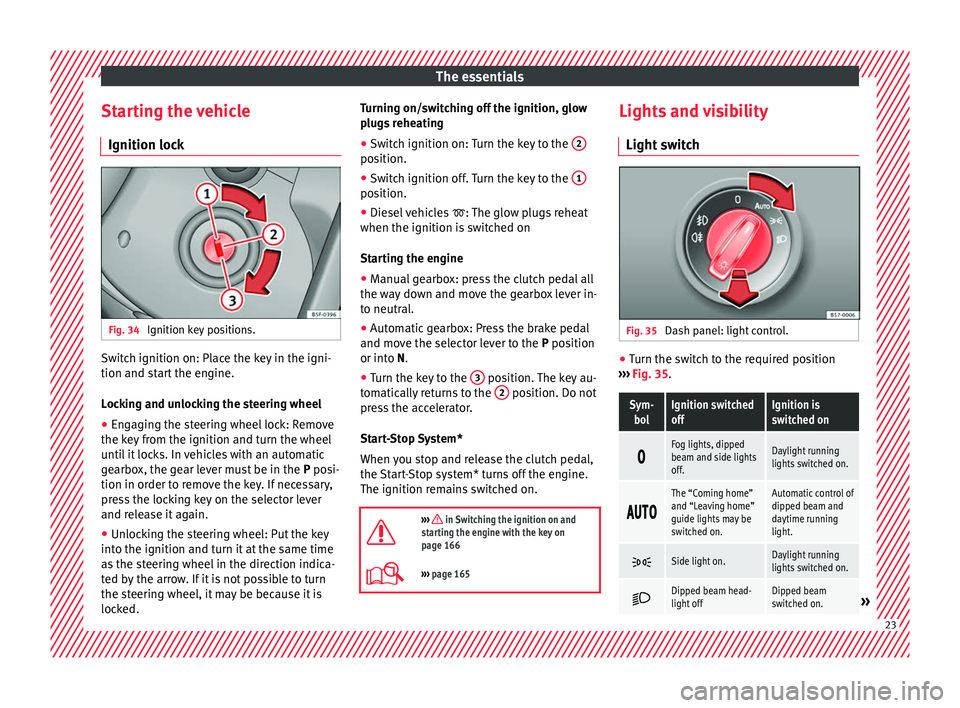
The essentials
Starting the vehicle Ignition loc kFig. 34
Ignition key positions. Switch ignition on: Place the key in the igni-
tion and s
t
art the engine.
Locking and unlocking the steering wheel
● Engaging the steering wheel lock: Remove
the key
from the ignition and turn the wheel
until it locks. In vehicles with an automatic
gearbox, the gear lever must be in the P posi-
tion in order to remove the key. If necessary,
press the locking key on the selector lever
and release it again.
● Unlocking the steering wheel: Put the key
into the ignition and t
urn it at the same time
as the steering wheel in the direction indica-
ted by the arrow. If it is not possible to turn
the steering wheel, it may be because it is
locked. Turning on/switching off the ignition, glow
plug
s reheating
● Switch ignition on: Turn the key to the 2 position.
●
Switch ignition off. Turn the key to the 1 position.
●
Diesel vehicles : The glo
w plugs reheat
when the ignition is switched on
Starting the engine
● Manual gearbox: press the clutch pedal all
the wa
y down and move the gearbox lever in-
to neutral.
● Automatic gearbox: Press the brake pedal
and mov
e the selector lever to the P position
or into N.
● Turn the key to the 3 position. The key au-
t om
atically returns to the 2 position. Do not
pr e
ss the accelerator.
Start-Stop System*
When you stop and release the clutch pedal,
the Start-Stop system* turns off the engine.
The ignition remains switched on.
››› in Switching the ignition on and
starting the engine with the key on
page 166
››› page 165 Lights and visibility
Light sw
itch Fig. 35
Dash panel: light control. ●
Turn the switch to the required position
› ›
› Fig. 35.
Sym-
bolIgnition switched
offIgnition is
switched on
Fog lights, dipped
beam and side lights
off.Daylight running
lights switched on.
The “Coming home”
and “Leaving home”
guide lights may be
switched on.Automatic control of
dipped beam and
daytime running
light.
Side light on.Daylight running
lights switched on.
Dipped beam head-
light offDipped beam
switched on.»
23
Page 26 of 328
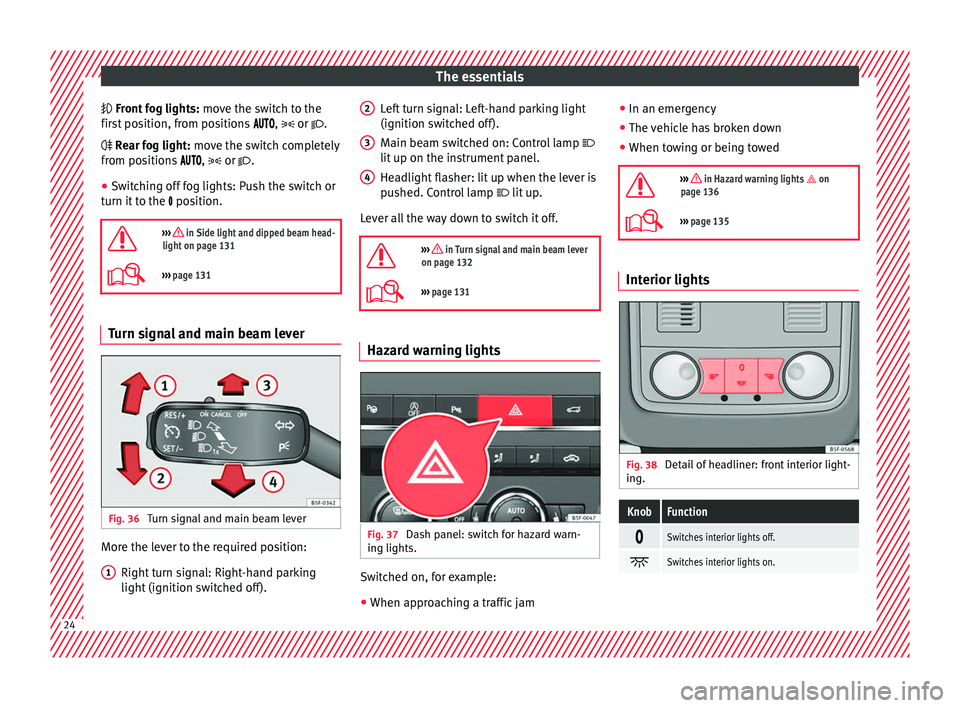
The essentials
Fr ont fog lights:
mo ve the switch to the
first position, from positions , or .
Rear fog light: move the switch completely
from positions , or .
● Switching off fog lights: Push the switch or
turn it
to the position.
››› in Side light and dipped beam head-
light on page 131
››› page 131 Turn signal and main beam lever
Fig. 36
Turn signal and main beam lever More the lever to the required position:
Right t
urn signal: Right-hand parking
light (ignition switched off).
1 Left turn signal: Left-hand parking light
(ignition sw
it
ched off).
Main beam switched on: Control lamp
lit up on the instrument panel.
Headlight flasher: lit up when the lever is
pushed. Control lamp lit up.
Lever all the way down to switch it off.
››› in Turn signal and main beam lever
on page 132
››› page 131 Hazard warning lights
Fig. 37
Dash panel: switch for hazard warn-
in g lights. Switched on, for example:
●
When approaching a traffic jam
2 3
4 ●
In an emer g
ency
● The vehicle has broken down
● When towing or being towed
››› in Hazard warning lights on
page 136
››› page 135 Interior lights
Fig. 38
Detail of headliner: front interior light-
in g.
KnobFunction
Switches interior lights off.
Switches interior lights on.
24
Page 27 of 328
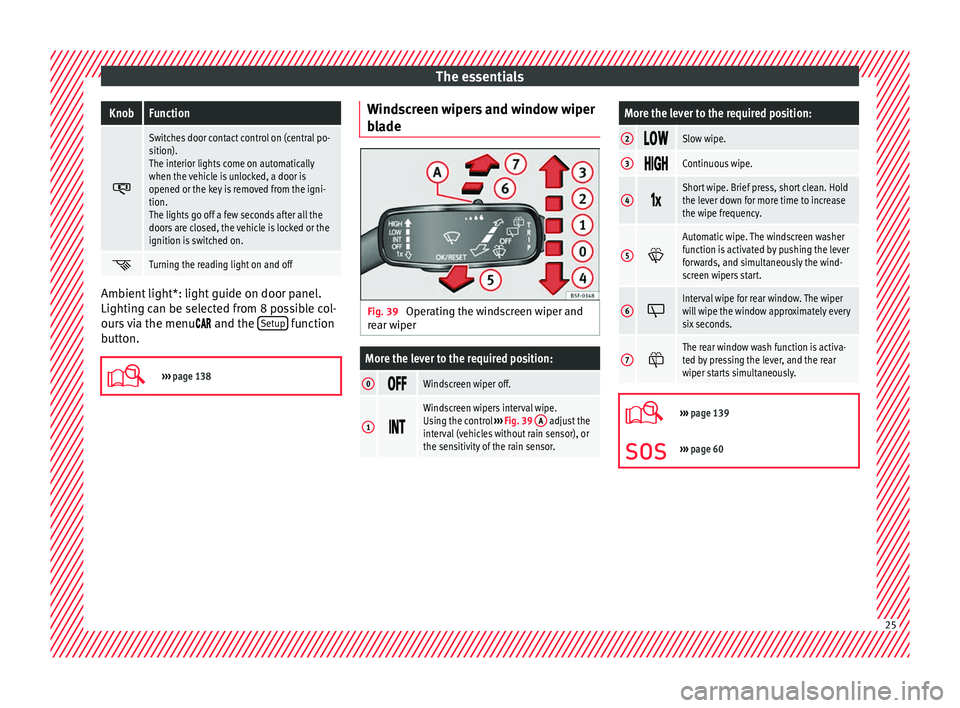
The essentialsKnobFunction
Switches door contact control on (central po-
sition).
The interior lights come on automatically
when the vehicle is unlocked, a door is
opened or the key is removed from the igni-
tion.
The lights go off a few seconds after all the
doors are closed, the vehicle is locked or the
ignition is switched on.
Turning the reading light on and off
Ambient light*: light guide on door panel.
Lightin
g c
an be selected from 8 possible col-
ours via the menu and the Setup function
b utt
on.
››› page 138 Windscreen wipers and window wiper
b
l
ade Fig. 39
Operating the windscreen wiper and
r e
ar wiper
More the lever to the required position:
0 Windscreen wiper off.
1
Windscreen wipers interval wipe.
Using the control
››› Fig. 39 A adjust the
interval (vehicles without rain sensor), or
the sensitivity of the rain sensor.
More the lever to the required position:
2 Slow wipe.
3
Continuous wipe.
4
Short wipe. Brief press, short clean. Hold
the lever down for more time to increase
the wipe frequency.
5
Automatic wipe. The windscreen washer
function is activated by pushing the lever
forwards, and simultaneously the wind-
screen wipers start.
6
Interval wipe for rear window. The wiper
will wipe the window approximately every
six seconds.
7
The rear window wash function is activa-
ted by pressing the lever, and the rear
wiper starts simultaneously.
›››
page 139
››› page 60 25
Page 28 of 328
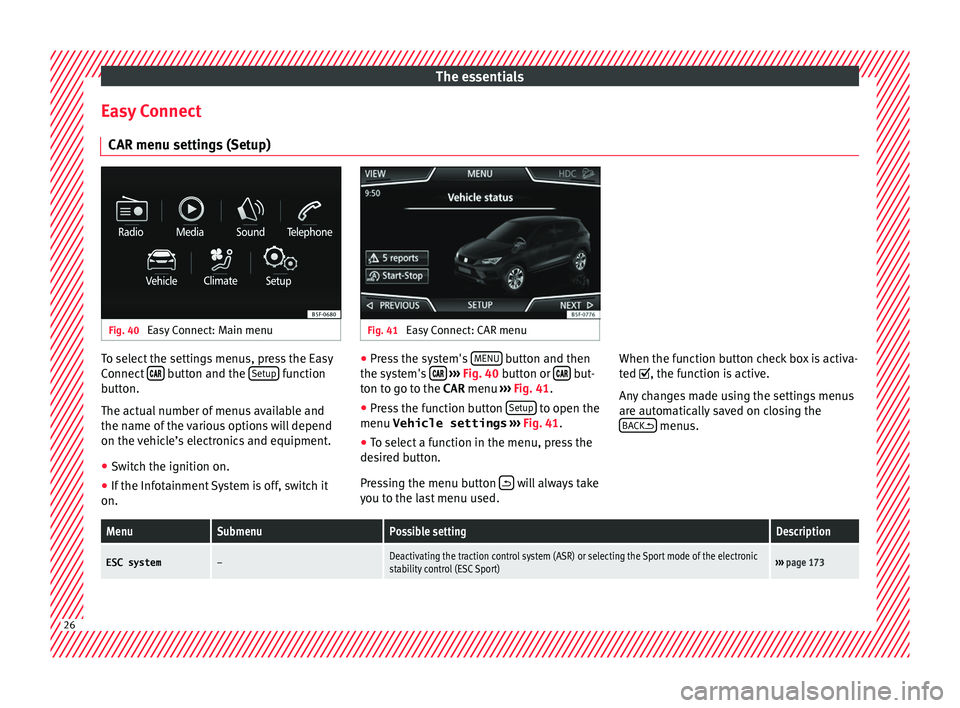
The essentials
Easy Connect CAR menu settin g
s (Setup)Fig. 40
Easy Connect: Main menu Fig. 41
Easy Connect: CAR menu To select the settings menus, press the Easy
C
onnect
button and the
Set
up function
b utt
on.
The actual number of menus available and
the name of the various options will depend
on the vehicle’s electronics and equipment.
● Switch the ignition on.
● If the Infotainment System is off, switch it
on. ●
Pre ss the system's MENU button and then
the sy s
tem's
› ››
Fig. 40 button or but-
t on t
o go to the CAR menu ››› Fig. 41.
● Press the function button Setup to open the
menu Vehicle settings › ›
› Fig. 41.
● To select a function in the menu, press the
des
ired button.
Pressing the menu button will always take
y ou t
o the last menu used. When the function button check box is activa-
ted
, the function is active.
Any changes made using the settings menus
are automatically saved on closing the BACK menus.
MenuSubmenuPossible settingDescription
ESC system–Deactivating the traction control system (ASR) or selecting the Sport mode of the electronic
stability control (ESC Sport)›››
page 173 26
Page 29 of 328
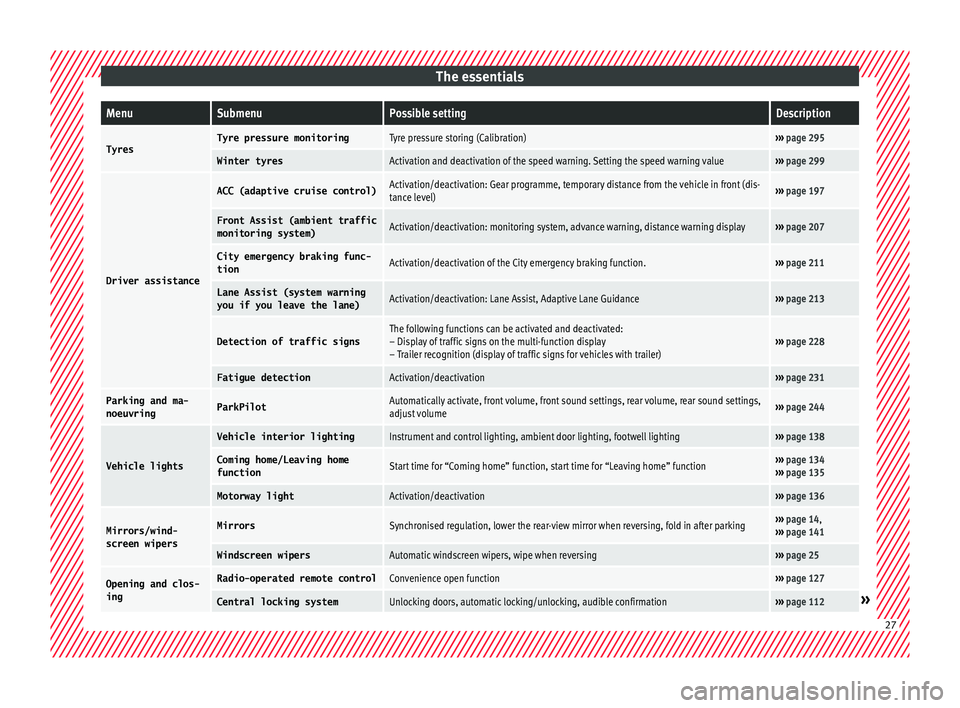
The essentialsMenuSubmenuPossible settingDescription
TyresTyre pressure monitoringTyre pressure storing (Calibration)›››
page 295
Winter tyresActivation and deactivation of the speed warning. Setting the speed warning value››› page 299
Driver assistance
ACC (adaptive cruise control)Activation/deactivation: Gear programme, temporary distance from the vehicle in front (dis-
tance level)››› page 197
Front Assist (ambient traffic
monitoring system)Activation/deactivation: monitoring system, advance warning, distance warning display››› page 207
City emergency braking func-
tionActivation/deactivation of the City emergency braking function.››› page 211
Lane Assist (system warning
you if you leave the lane)Activation/deactivation: Lane Assist, Adaptive Lane Guidance››› page 213
Detection of traffic signsThe following functions can be activated and deactivated:
– Display of traffic signs on the multi-function display
– Trailer recognition (display of traffic signs for vehicles with trailer)››› page 228
Fatigue detectionActivation/deactivation››› page 231
Parking and ma-
noeuvringParkPilotAutomatically activate, front volume, front sound settings, rear volume, rear sound settings,
adjust volume››› page 244
Vehicle lights
Vehicle interior lightingInstrument and control lighting, ambient door lighting, footwell lighting››› page 138
Coming home/Leaving home
functionStart time for “Coming home” function, start time for “Leaving home” function››› page 134
››› page 135
Motorway lightActivation/deactivation››› page 136
Mirrors/wind‐
screen wipersMirrorsSynchronised regulation, lower the rear-view mirror when reversing, fold in after parking››› page 14,
››› page 141
Windscreen wipersAutomatic windscreen wipers, wipe when reversing››› page 25
Opening and clos-
ingRadio-operated remote controlConvenience open function››› page 127
Central locking systemUnlocking doors, automatic locking/unlocking, audible confirmation››› page 112» 27
Page 30 of 328

The essentialsMenuSubmenuPossible settingDescription
Multifunction
display–
Current consumption, average consumption, volume to fill up, convenience consumers,
ECOAdvice, travelling time, distance travelled, digital speed display, average speed, speed-
ing warning, oil temperature, coolant temperature, restore data “from start”, restore data
“total calculation”
››› page 29
Date and time–Time source, set the time, automatic summer time (DST) setting, select time zone, time for-
mat, set the date, date format–
Measurement units–Distance, speed, temperature, volume, consumption–
Service–Chassis number, date of next SEAT service inspection, date of next oil change service››› page 35
Factory settings–All settings can be reset: driver assistance, parking and manoeuvring, lights, rear view mir-
rors and windscreen wipers, opening and closing, multi-function display–
››› in CAR menu (Setup) on page 108
›››
page 108 28